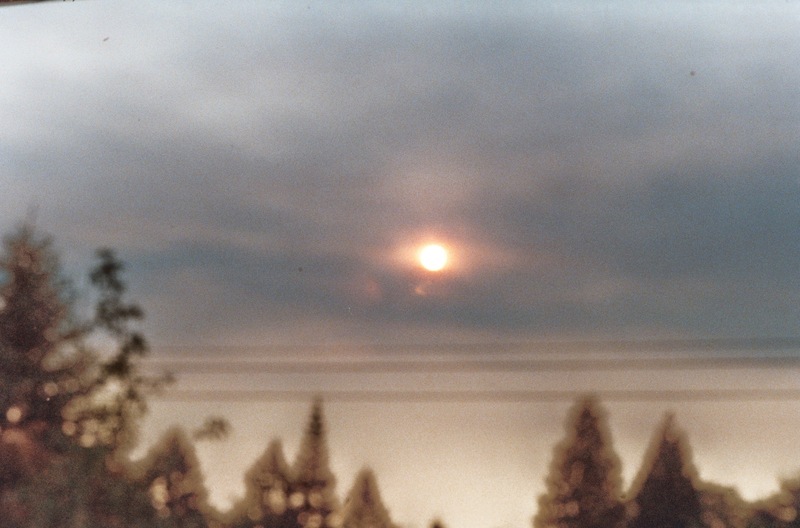Canadian Wildfire Smoke's Impact On New York: Temperature Changes And Air Toxicity

Table of Contents
Temperature Changes Caused by Canadian Wildfire Smoke
The presence of dense Canadian wildfire smoke significantly alters New York's temperature patterns in several ways.
The Impact of Smoke on Sunlight and Temperature
Smoke plumes act as a barrier, absorbing and scattering incoming sunlight. This reduces the amount of solar radiation reaching the Earth's surface, leading to a noticeable decrease in daytime temperatures. Studies have shown temperature reductions of several degrees Celsius during peak smoke events. This phenomenon is further exacerbated by the smoke's interaction with the atmosphere, potentially increasing the "heat island effect" in urban areas, leading to slightly higher nighttime temperatures as the trapped heat radiates back down. The decrease in solar radiation is a key factor in the overall temperature reduction observed across the city. The impact on solar radiation is directly proportional to the density and persistence of the smoke plumes.
Secondary Effects on Temperature Patterns
The intrusion of Canadian wildfire smoke disrupts established weather patterns. The smoke particles can affect precipitation, potentially suppressing rainfall and contributing to drier conditions. Furthermore, the presence of smoke can alter wind patterns, influencing the movement of air masses and potentially influencing the temperature distribution across the region. These weather disruption effects are complex and require further research to fully understand their long-term implications on New York's climate.
Air Toxicity and Health Risks Associated with Canadian Wildfire Smoke
The air quality during periods of significant Canadian wildfire smoke is severely compromised.
Composition of Wildfire Smoke and its Harmful Components
Wildfire smoke is a complex mixture of pollutants, with particularly harmful components including PM2.5 (fine particulate matter), PM10 (coarse particulate matter), carbon monoxide, and ozone. These air pollution sources pose significant threats to human health. Inhaling PM2.5, for instance, is linked to severe respiratory illness, including asthma attacks and bronchitis, while prolonged exposure can contribute to cardiovascular disease. Exposure to high levels of carbon monoxide can lead to carbon monoxide poisoning, while ozone can trigger respiratory irritation and worsen existing conditions. The concentration of these pollutants directly relates to the severity of the health impacts.
Impact on Vulnerable Populations
The health risks associated with Canadian wildfire smoke are significantly higher for vulnerable populations. This includes children, the elderly, and individuals with pre-existing respiratory illnesses such as asthma or Chronic Obstructive Pulmonary Disease (COPD). These groups often have compromised respiratory systems, making them more susceptible to the harmful effects of air pollution. Protecting the health of these vulnerable populations is paramount during smoke events. Individuals with cardiovascular conditions are also at increased risk, as are pregnant women.
Air Quality Index (AQI) and Public Health Alerts
The Air Quality Index (AQI) is a crucial tool for monitoring and communicating air quality levels. New York City and surrounding areas utilize the AQI to issue public health alerts when air quality deteriorates due to Canadian wildfire smoke or other pollution sources. Understanding AQI levels is essential for individuals to take appropriate protective measures. Regular monitoring of the AQI enables proactive responses, safeguarding public health during critical periods of elevated air pollution.
Mitigation and Preparedness Strategies for Canadian Wildfire Smoke Events in New York
Effectively mitigating the impact of Canadian wildfire smoke requires a multi-pronged approach.
Individual Protective Measures
During periods of high Canadian wildfire smoke concentration, individuals should prioritize reducing exposure. This includes staying indoors, especially during peak pollution times, using high-efficiency particulate air (HEPA) air purifiers, and limiting strenuous outdoor activities. In cases of extreme smoke, the use of N95 masks can be beneficial, though their effectiveness can vary depending on the type of mask and the concentration of pollutants. Focusing on reducing exposure is key to protecting your health.
Governmental and Institutional Responses
Effective government response is crucial for mitigating the effects of Canadian wildfire smoke. Local, state, and federal agencies play a vital role in monitoring air quality, issuing timely public health alerts, and implementing strategies to improve preparedness. These initiatives include investing in advanced air quality monitoring networks, developing and disseminating effective communication strategies, and supporting research into air quality improvements. This encompasses improving emergency preparedness measures and bolstering public health initiatives aimed at reducing the long-term health consequences of air pollution.
Conclusion
The impact of Canadian wildfire smoke on New York is undeniable, causing significant temperature changes and severely impacting air quality, posing considerable health risks, particularly to vulnerable populations. The consistent disruption to daily life underscores the need for comprehensive strategies to monitor and mitigate the effects of these increasingly frequent events. To protect yourself and your community, stay informed about Canadian wildfire smoke events by regularly checking the AQI. Take proactive steps to reduce your exposure, such as using air purifiers and limiting outdoor activities during high-pollution periods. By staying informed and taking appropriate precautions, we can collectively work toward improving air quality and reducing the impact of future Canadian wildfire smoke events, improving our collective health and wellbeing. Support initiatives aimed at improving air quality and preparing for future incidents of Canadian wildfire smoke, working to ensure that New York is better equipped to address this growing environmental challenge.

Featured Posts
-
 Sanofi Quel Potentiel Boursier Reste T Il L Avis De Loeil Du Loup De Zurich
May 31, 2025
Sanofi Quel Potentiel Boursier Reste T Il L Avis De Loeil Du Loup De Zurich
May 31, 2025 -
 Sanofi Uebernimmt Mittel Gegen Autoimmunerkrankungen Fuer Bis Zu 1 9 Milliarden Us Dollar
May 31, 2025
Sanofi Uebernimmt Mittel Gegen Autoimmunerkrankungen Fuer Bis Zu 1 9 Milliarden Us Dollar
May 31, 2025 -
 Delaying Ecb Rate Cuts Economists Sound The Alarm
May 31, 2025
Delaying Ecb Rate Cuts Economists Sound The Alarm
May 31, 2025 -
 Le Game De Dahu 1 Un Jeu Et Concours A Saint Die Des Vosges
May 31, 2025
Le Game De Dahu 1 Un Jeu Et Concours A Saint Die Des Vosges
May 31, 2025 -
 Is Parker Meadows Returning Soon A Detroit Tigers Notebook Update
May 31, 2025
Is Parker Meadows Returning Soon A Detroit Tigers Notebook Update
May 31, 2025
